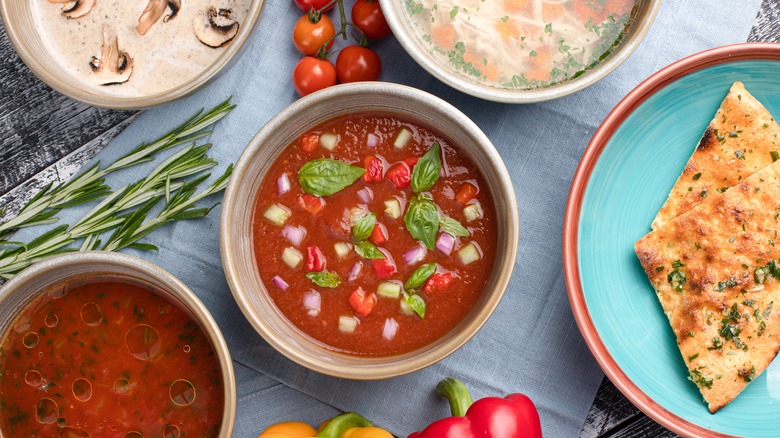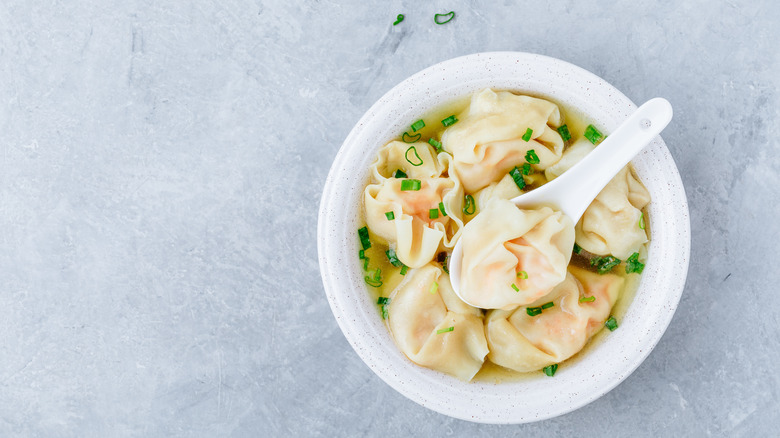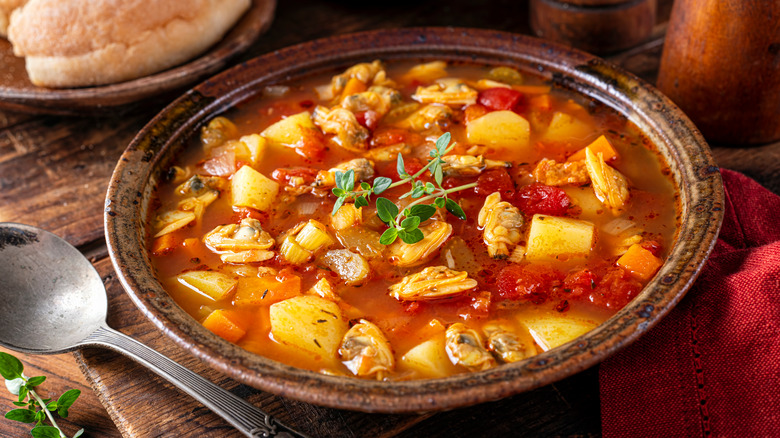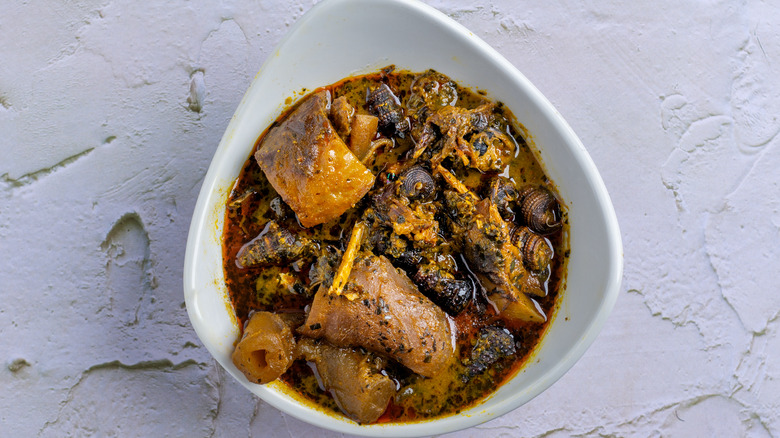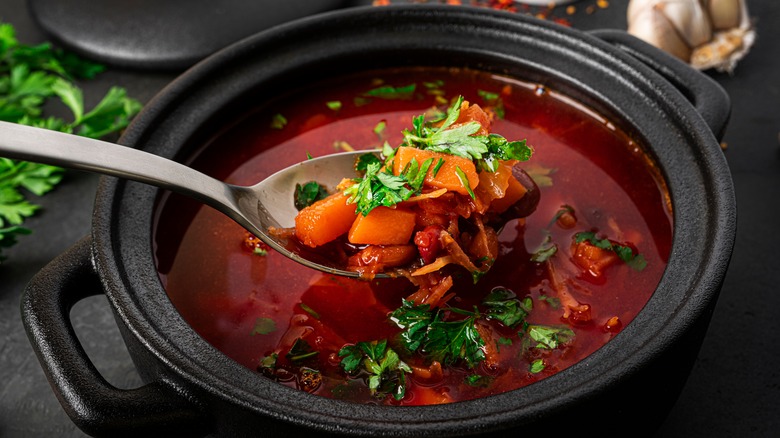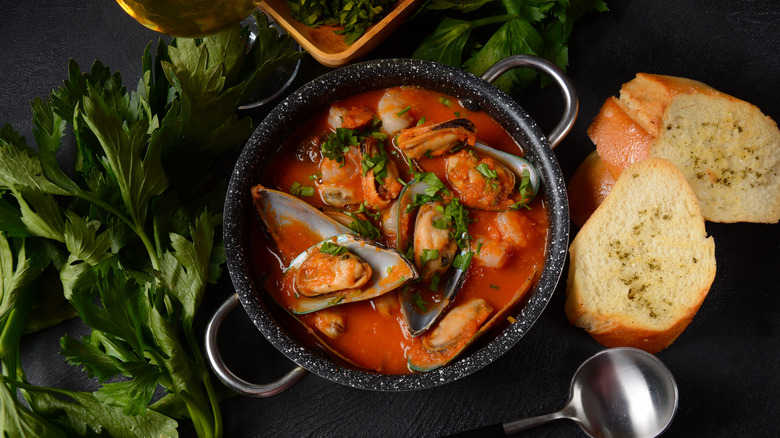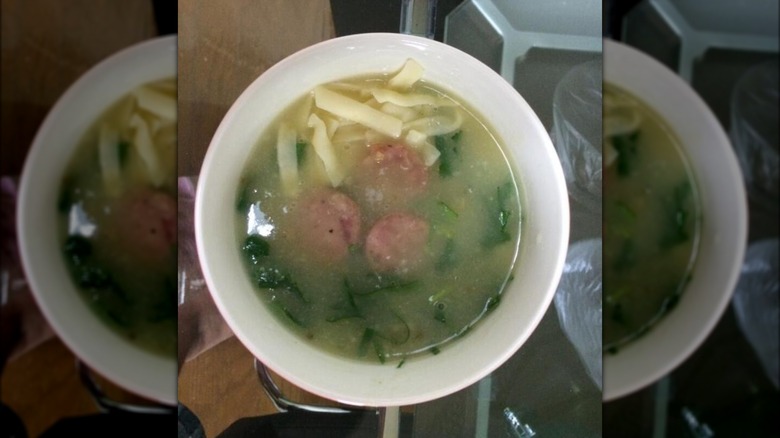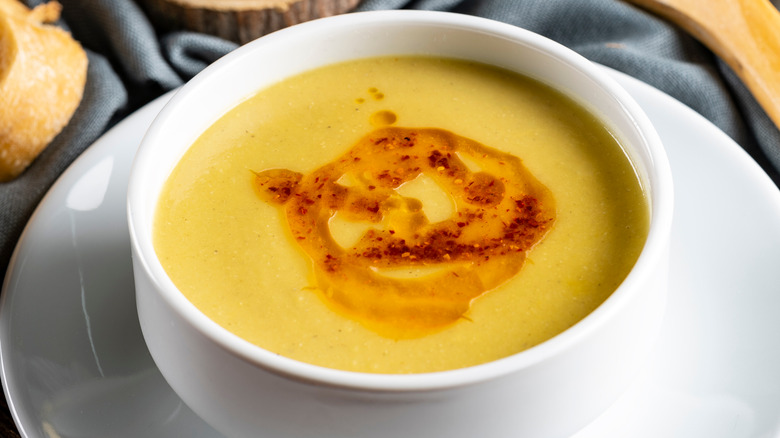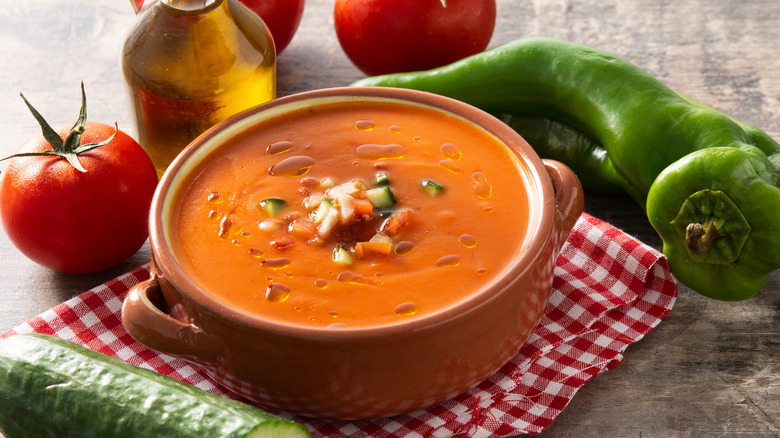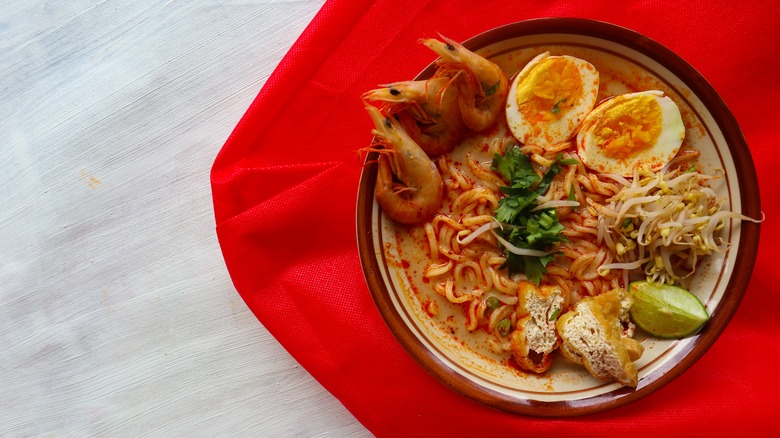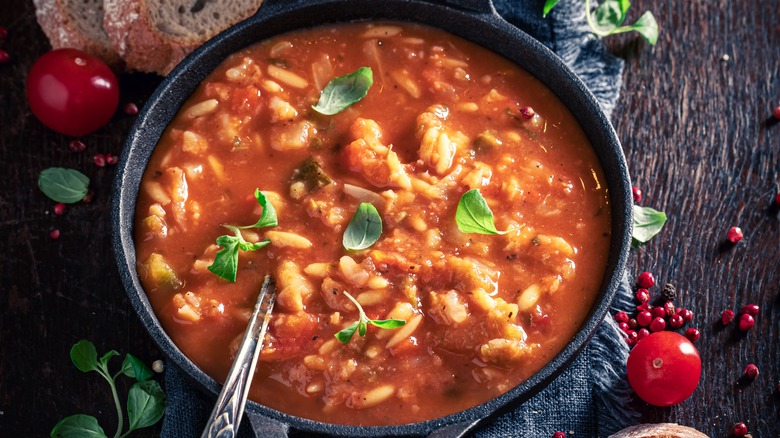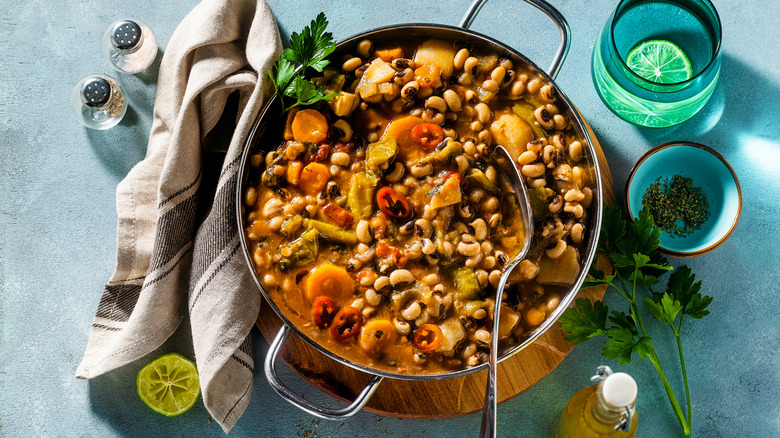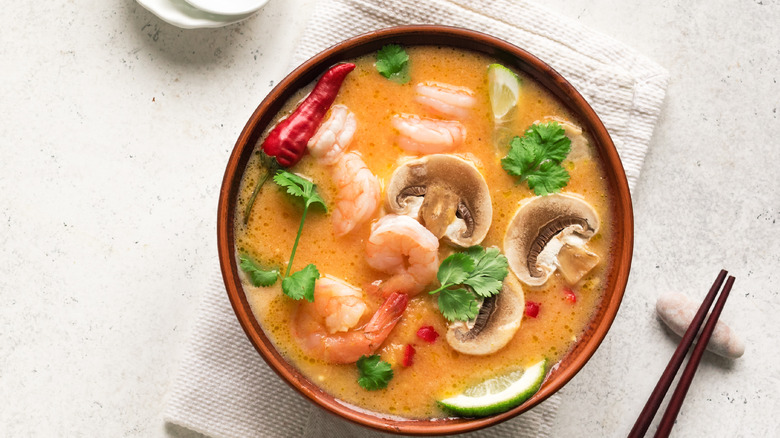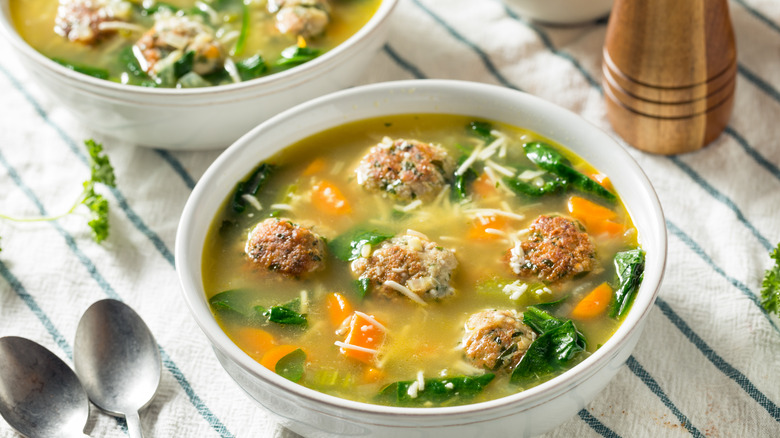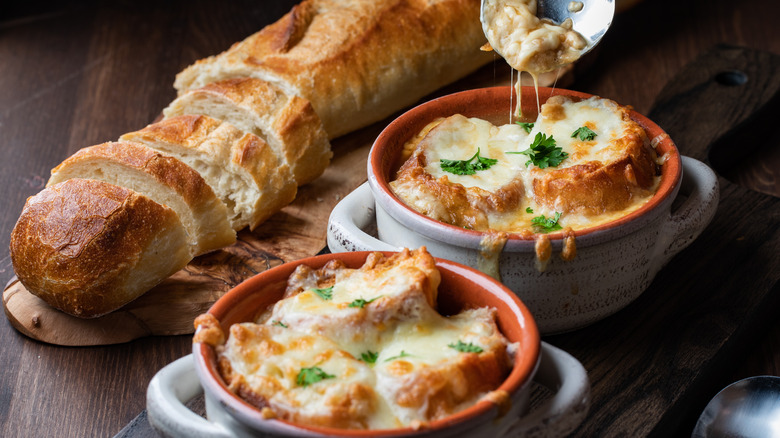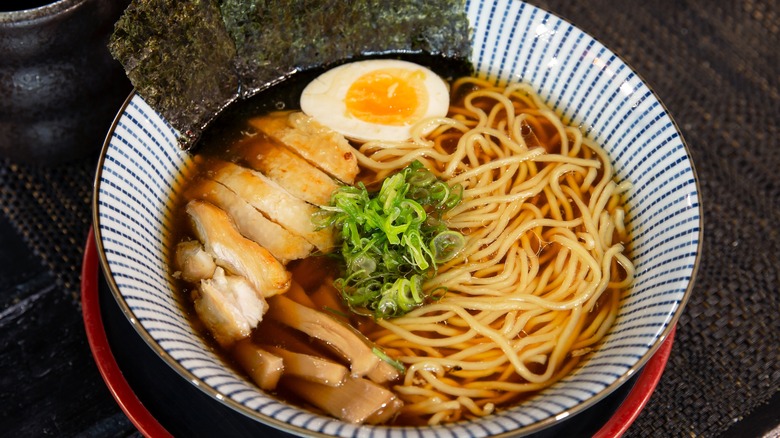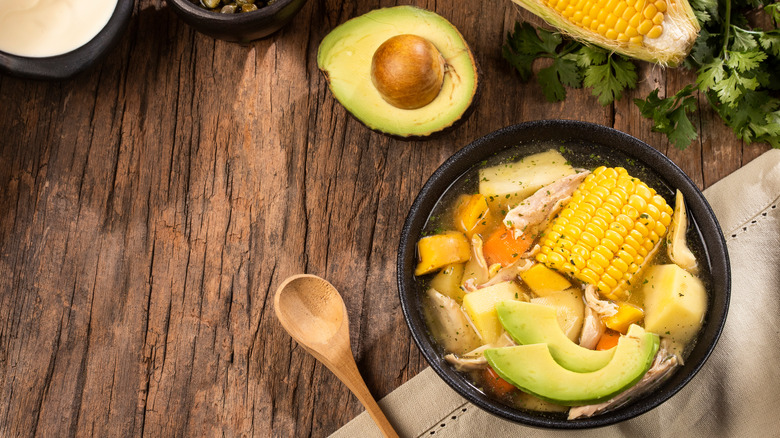16 Of The Most Delicious Soups From Around The World
There's no doubt about it: People love soup. Hearty, comforting, and packed with flavors, there's a reason why the worldwide soup market was valued at $16.1 billion in 2018 (via Grand View Research). Perhaps the biggest reasons soup is so popular with the masses is that it's familiar, comforting, and affordable.
That's not the only reason soup is such a widespread cuisine. As per Healthline, soups can be incredibly nutritious and loaded with essential vitamins and minerals. Whether you are down with a cold or looking for a hangover cure, soup readily comes to the rescue. However, if you think that your typical chicken noodle soup is all there is to this style of meal, then you are in for a surprise.
Below, we've rounded up some of the most delicious soups from around the world. If you're looking to expand your soup-drinking palate, this guide will ensure that you're cooking and enjoying different types of soups in practically no time.
Wonton soup
It's a cotton ball. It's a cloud. No, it's a wonton in a bowl of piping hot soup. Wonton soup got its name from the cloud-like dumplings in the bowl; wonton translates to "cloud" in Cantonese (via Food & Drink). The wontons, made of a thin flour wrapping with a protein-rich filling, add complexity as well as meat to the flavorful soup.
As per Visit Richmond BC, wonton soup dates back to China's Qing Dynasty in 1664, where it was considered food for the elite class only. It gained popularity in post-World War II Hong Kong, where it was served to the working class from street stalls. Today wonton soup has made its way around the globe, where many variations of the basic form exist. Unsurprisingly, it's now a popular item on Chinese restaurants menus.
According to Rice Bowl Deluxe, this Chinese delicacy must be assembled and served in a very particular way. First, the soup spoon is placed in the bowl, followed by the wontons, garnishes, and then noodles. Finally, the delicious broth is poured over the contents of the bowl. Some restaurants may also serve wontons and noodles separately, with a bowl of broth on the side, allowing customers to assemble the soup to their own liking.
Clam chowder
The creamy, heavenly clam chowder is a classic and, for many, a favorite soup. There's a lot to love, from the chunks of potatoes that melt in your mouth, to the briny ocean-like taste of the clams, to the broth bursting with fresh flavor. These are all reason enough for a second serving.
Per AllBig, the soup's origins date back to the late 17th century, when the French settlers came to North America. After teaming up with other immigrants to New England, settlers likely made the first chowders with fish, onion, breadcrumbs, and salt pork. A surplus of clams pushed them to change the recipe and create the now-famous clam chowder.
When it comes to clam chowder, the varieties are virtually endless. Some are made with tomatoes instead of cream for a translucent broth, while other variants use a combination. Regardless, the soup is absolutely delicious no matter which version you eat, and that's a guarantee. Currently, clam chowder is usually made with a delightful combination of potatoes, milk, salt pork, and clams. Most people use quahog clams, which have a sweet flavor and tender meat that should be chopped before adding to the soup (via New York Times).
Banga
Banga tastes fantastic and, as many satisfied diners will tell you, the flavor profile hits just the right notes. Much like the soup's texture, banga also has a rich history. According to TasteAtlas, banga, a Nigerian dish also known as palm nut soup, is made with palm nut pulp, meat (typically fish or crab), onions, tomatoes, and spicy seasoning.
Five thousand years ago, the palm nuts at the heart of this soup were considered a staple crop. After the rise of the Industrial Revolution in Britain increased demand for the ingredient, palm nuts hit the international market. Palm oil, extracted from the palm nuts, became common across the globe and particularly in Europe (via Soups Junction).
Palm nuts are loaded with nutrients, per the Asian Pacific Journal of Clinical Nutrition. This helps to make banga a seriously healthy soup full of antioxidants. To enjoy it, many serve banga hot. However you enjoy it, the intense flavor is bound to make you a fan.
Borscht
We don't know precisely when or where the borscht arose, but it was somewhere between the fifth and ninth centuries in what's now Ukraine, according to History Today. Back then, borscht soup was deemed to be peasant food that hardly ever touched the table of nobles.
It was not until the late 17th century that this healthy soup began to spread across cultures and social boundaries. The ingredients used varied, too, typically reflecting what was available once the local harvest was brought in. Interestingly, the Slavic word for cow parsnip, one of the older ingredients in borscht, is what gives this soup its name (via History Today).
Today, this tangy soup is typically made with beetroot, which gives borscht its now-iconic luscious red color. Per Britannica, borscht is also full of meaty goodness along with chopped vegetables and sour cream. There's still plenty of room for variation on modern tables. In Poland, this dish is often served with dumplings full of savory mushrooms. Traditionally this soup is served together with a loaf of hearty black bread as well.
Bouillabaisse
While "bouillabaisse" may be difficult for newbie French speakers to pronounce, it's definitely easy on the taste buds. With its lengthy list of ingredients and the fancy French name, the bouillabaisse is often served in Michelin-starred restaurants, and rightfully so (via Martha Stewart). The complexity of flavors, long ingredients list, and the skill needed to make it not only tags bouillabaisse as an expensive soup but a favorite amongst seafood lovers. In fact, bouillabaisse was so beloved by 19th-century British writer William Makepeace Thackeray that he wrote a ballad about the soup. In it, he raves about the soup, calling it a "noble dish" made with a "hotchpotch of all sorts of fishes" and herbs (via Bartleby).
Bouillabaisse is a gift to the world from Marseille, where it was first made from the scraps of leftover fish. It's come a long way from such humble origins. Today, a bowl of bouillabaisse can cost a pretty penny in its fanciest restaurant form, per NPR.
According to Experience Transat, the traditional bouillabaisse recipe includes a blend of local fish, namely conger eel, red mullet, red scorpion fish, rockfish, and spider crab. Because it's best enjoyed with high-quality seafood, it's easy to see how this soup can get pretty expensive.
Caldo verde
Caldo verde is a hearty Portuguese soup made with collard greens and is a traditional dish served on cold winter nights. Caldo verde, or green soup, is so beloved that it's won the title of one of the seven wonders of Portuguese cuisine (via bePortugal). The soup has its roots in the region of Minho, where it's served with onion puree and potatoes.
The soup was originally made with cheap and accessible ingredients, but the wonderfully rich taste made it popular. Locals would even have this soup as dinner, given the high nutritiousness of the soup's collard greens, providing all the energy of a full meal (via bePortugal)
Today the delicious soup is still a favorite, the aroma alone enticing diners to grab a second bowl for another dose of vegetable goodness. According to Taste Braga, chorizo, added just before serving, is a staple ingredient that adds protein and rich flavor. Cabbage also adds a leafy hit to the savory dish, while cornbread is often served alongside the soup. Eat it with a glass of chilled wine for the most authentic experience of all.
Mercimek çorbası
Mercimek çorbası is a Turkish soup favorite made from red lentils and vegetables. Its origins date back to the Neolithic era, when lentils were an early agricultural crop. Perhaps you'd find more history than broth in a bowl of mercimek çorbasi. Lentil soups have also been mentioned in 19th-century Turkish cookbooks. Today, mercimek çorbası is still widely enjoyed, especially during Ramadan. Then, Muslims might enjoy it as the first meal after sunset ends the day's fast (via World Food Story).
Per Healthline, lentils are rich in protein, vitamin B, magnesium, and iron. It's also made of accessible ingredients. World Food Story notes that a traditional red lentil soup is made by sauteing onions, carrots, potatoes, and tomato paste. It's all blended together to create the creamy soup.
According a mercimek çorbası fan on Reddit, the taste of red lentil soup has an earthy and nutty flavor that could be further improved with a bit of garlic.
Gazpacho
Though it's now closely tied to Spanish cuisine, gazpacho actually has its roots in the ancient Roman and Greek cultures. It is said that Roman soldiers used to carry pieces of bread, garlic, and olive oil with them. During long journeys across the empire, they would use these ingredients to make a simple soup, typically mashing them together. Others point to Moroccan origins in their bowl of gazpacho, noting that Moorish settlers in the region made a similar soup using almonds (via Amigo Foods).
The gorgeous red color of gazpacho comes from the ripe red tomatoes that are central to this classic soup, served hot or cold. Those tomatoes are blended with garlic, stale bread, olive oil, and vinegar. While we don't know exactly how the soup got its name, the word does translate to "soaked bread" in Arabic, per Britannica. Considering the fact that bread is so central to this blended soup dish, that translation is especially apt.
Laksa
Laksa is a oftentimes spicy, savory noodle soup with many different variants. This rich soup is influenced by three different cultures: Chinese, Malay and Indonesian. There are two main varieties of this soup, namely curry and Assam laksa. The first is a tasty blend of coconut milk and curry paste with chillies on top for a raging flavor. Ingredients like fish balls tofu puffs are often thrown in the mix for more complexity and depth of flavor. Conversely, Assam laksa is lighter in flavor as well as contents. It is made with fish, torched ginger flowers, and tamarind (via Asian Inspirations).
According to Mashable, laksa has its origins in the 15th century, when Chinese traders began trading in the Malay archipelago. Some locals and visitors soon found themselves smitten with each other, both in the kitchen and beyond. The intercultural marriage of people and cuisines resulted in the transformation of traditional Chinese soups with local spices and other flavorings. It all resulted in the dish now known as laksa.
Minestrone
Minestrone gained popularity in 2nd century Italy, when various vegetables were available to the local population for use in this now classic vegetable soup. Its historical importance rose further during the First World War, when food was scarce. Local farmers made do with what ingredients they had, mainly salt and vegetables.
The beauty of minestrone is its flexibility, allowing you to incorporate whatever vegetables are on hand. You can even make it from leftovers, as Italian peasants often did. All it needs are some essential ingredients, such as onions, carrots, celery, cabbage, and beans. Add in whatever other ingredients strike your fancy, cook it over a low flame, and you can have a bowl on minestrone ready to so. It's very well-suited to use up those leftovers sitting in your fridge's vegetable drawer.
Per The Guardian, you can also pair this soup with rice, pasta, or bread, along with some grated parmesan, and enjoy it as a complete meal. The process of this soup can be as complex or as straightforward as you like, depending on the occasion, the mood of the cook, or simply the availability of the ingredients.
Black-eyed pea soup
While legend has it that eating these black-eyed peas on the first day of the new year brings prosperity, you can still enjoy it as a hearty bowl of soup any day of the year. Black-eyed pea soup is, naturally enough, made from black-eyed peas, which are actually beans. The flavor profile of this soup is flavorful, zesty, creamy, and rich, much like its history.
Though it's a considered an American dish nowadays, these beans are actually native to West Africa. They were introduced to the United States in the 17th century during the transatlantic slave trade and now offer an opportunity to connect with the history of Black Americans (via Physicians Committee for Responsible Medicine).
Per The Washington Post, this soup a relatively simple concoction of vegetables, herbs, and yummy black-eyed peas, sometimes blended into an aromatic puree. You can easily pair it with some bread and salad to make it a hearty and delicious meal.
Tom yum
It is said that tom yum soup originated in Central Thailand, where both then and today you can find plenty of shrimp and pots ready to make this dish that's nigh on liquid gold. Nowadays, you'll find this soup served far afield, such as at London's Thai Square restaurant (via Thai Square). Per Vietnam Times, the name "tom yam" translates to words that describe it; boiling, hot, sour, and spicy.
The three core ingredients in tom yum soup are lemon grass, kaffir lime leaves, and galangal, which make all the difference in transforming it from an average-tasting broth to a finger-licking "I want another please" bowl of soup. Shrimp is also a popular addition to the bowl
According to Thai Square, the addition of coconut milk and substitution of shrimp with chicken or other meat is a matter of preference. Other staple ingredients typically include lime juice, fish sauce, crushed peppers, and plenty of additional seasoning.
Italian wedding soup
Contrary to what the name suggests, you won't typically find Italian wedding soup at a wedding. It's so named because the recipe is considered to be a harmonious marriage of ingredients. The result of this culinary matrimony is a deeply pleasing blend of vegetables and meat stewed in a flavorful broth (via Nonna Box).
Like so many dishes, Italian wedding soup began as a thrifty peasant food that transformed into a widely popular winter meal. According to Food Republic, it originated in the Campania region of Italy, where the soup was associated with the winter slaughter of pigs. Their bones would be boiled with leftover prosciutto, alongside a variety of greens.
In Naples, this dish was historically enjoyed during the Feast of Santo Stefano on December 26. American cooks added their own spin, such as the addition of meatballs and fewer vegetables, creating a version that soon began filling the bowls of citizens across the country. According to Streets of New York, Italian wedding soup can now be made with leafy greens like kale, spinach, or cabbage, as well as proteins like meatball, sausages, or chicken.
French onion soup
With origins in ancient Rome, onion soup was yet another creation meant for lean times and tight budgets. It was picked up by the French in the late 18th century, where it had transformed into a higher-class concoction of rich beef broth with caramelized onions. It became especially popular in midcentury America after French-trained chefs like Julia Child popularized the dish all over again (via The Ellsworth American).
This savory soup all about the caramelized onions, which are broken down over an hours-long cooking period. The final soup can be spiked with a bit of fortified wine like sherry or spirits such as brandy to give it a flavourful kick. It's also often paired with grated cheese on top and a side of crusty bread, according to Vice.
According to Paris restaurant Pied de Cochon, French onion soup is a diner favorite that never goes off the menu. It's ordered for festive occasions as well as by regular clients. In fact, the restaurant's staff teams up with other establishments to supply the infamous soup to the poor (via Vice).
Ramen
Popular as ramen is today, its origins remain a mystery, though it is widely believed that has its roots in a dish brought over from China. Perhaps the most believable of ramen's origin myths is that it got its start in Tokyo's Rai Rai Ken restaurant, which employed Chinese people. There, during the 1900s, an early variation of ramen known as shina soba was served. It included ingredients that are familiar to modern ramen fans, such as seaweed, fish cake, and roasted pork. Increasing urbanization and industry help boost ramen's profile, as the soup was a hearty, filling meal for urban workers (via Noodles on the Silk Road).
Regardless of how it came to be, ramen is seriously tasty. Per The Guardian, a typical recipe of Japanese ramen consists of four essential elements: a seasoning base, broth, noodles, and toppings. Those toppings can include a wide variety of things, like roasted pork, green onions, pickled bamboo shoots, and nori, a type of seaweed.
Ajiaco Colombiano
Ajacio Colombiano is a traditional cream Colombian soup made from chicken and potatoes. According to Culture Trip, the local people of Cundinamarca used to eat a soup that consisted of a corn-based broth and aji potatoes. When Spanish conquistadores and other colonizers arrived in the region, they tweaked the recipe by adding chicken and cream, which led to the development of today's ajaccio Colombiano.
Now, ajiaco is served with rice or stewed chicken and is considered to be part of a hearty Colombian meal. It's also often named the favorite food of the inhabitants of Colombia's capital, Bogotá. A typical bowl of ajiaco will consist of guascas, potatoes, chicken, and corn on a cob (via Amigo Foods).
According to a fan of this soup writing on Quora, you'll find the best ajiaco is made in the restaurant El Concejal in la Plaza de la Perseverancia in Bogotá.
